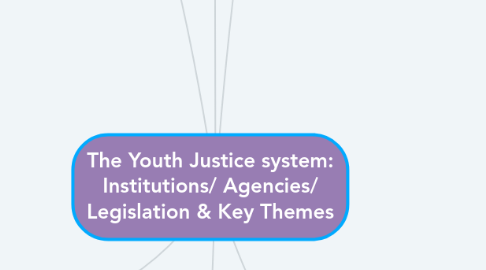
1. Institutions
1.1. Custody
1.1.1. Secure Care Home (SCH) 10-17 yo held by the local authorities running specialist interventions, a school timetable and training
1.1.2. Young Offenders Institution (YOI) 15-17 yo majority ran by Prison service, housing young people in wings of 30-60 with a stricter regime similar to adult prisons
1.1.2.1. 8 YOI's in England & Wales
1.1.2.1.1. Ashfield, Cookham Wood, Feltham, Wetherby, Werrington, Warren Hill, Parc, Hindley
1.1.3. Secure Training Centre (STC) 12-17 yo holding more vulnerable young people, with units housing 5-8 young people and and a high staff ratio
1.1.3.1. Medway
1.1.3.2. Oakhill
1.1.3.3. Rainsbrook
1.2. YJB Placements team
1.2.1. deal with the costing and allocation of bed spaces in YOIs, STCs and SCHs vary
1.2.1.1. SCHs are most expensive, followed by STCs then YOIs.
1.3. specialist interventions
1.3.1. caseworkers
1.3.2. Psychologists
1.3.3. Healthcare provision
1.3.3.1. Nurse
1.3.3.2. Dentist
1.3.3.3. Opticians
1.3.4. Social workers
1.3.4.1. Home authority
1.3.4.2. LADO to esablishment
1.4. disadvantaged background
1.5. Remand
1.5.1. RCLA Remand to the Care of Local Authority
1.5.2. RSDC Remand to a Secure Detention Centre
2. Theory
2.1. Structure
2.1.1. Social, economic and political factors contribute to offending behaviour
2.1.2. Social structure must change to aid the rehabilitation of young people who offend
2.2. Agency
2.2.1. Offending behaviour is rooted in the individual in all cases
2.2.2. The individual should be disciplined and rehabilitated to meet society's standards
2.3. Criminological theory
2.3.1. Rational Actor Model
2.3.1.1. offenders enjoy an ability to choose their involvement in crime
2.3.2. Predestined Actor Model
2.3.2.1. internal or external factors which have an impact on the way offenders act, with little or no control over their actions
2.3.3. Victimised Actor Model
2.3.3.1. Offenders are victims of unequal stand point in society
3. Multi-agency approach
3.1. Police
3.1.1. Arrested
3.1.1.1. No Further Action
3.1.1.2. Formal Charge
3.1.1.2.1. YOTs
3.1.1.2.2. Court
3.1.1.3. Community resolution
3.1.1.4. youth caution
3.1.1.5. youth conditional caution
3.1.2. Not Arrested
3.1.2.1. note on file
3.1.2.2. social services interventions
3.2. Youth Offending Teams
3.2.1. multi faceted agency
3.2.1.1. Police
3.2.1.2. Probation
3.2.1.3. social workers
3.3. The Courts
3.3.1. in and out of court disposals
3.4. Healthcare
3.4.1. Psychologist
3.4.2. Psychiatrists
3.4.3. Nutritionists
4. Statistics
4.1. Age
4.1.1. 10-17 year old
4.1.2. 80% are 15-17
4.2. Gender
4.2.1. Females more vulnerable (Bateman 2016)
4.2.1.1. fewer females in system
4.3. Ethnicity
4.3.1. Majority white
4.3.2. BAME over-represented
4.3.2.1. In custody, 40% are from BAME backgrounds
4.4. Social Deprivation
4.4.1. poverty
4.4.2. social services intervention during childhool
4.4.2.1. Foster care
4.4.2.1.1. secure placements
5. Key Themes
5.1. Effective Practice
5.1.1. "Practice which produces the desired outcome" (2013)
5.1.1.1. YJB Standards of conduct
5.1.1.2. YJB mission statement
5.1.1.3. Preventing re-offending
5.1.1.3.1. Aim of YJB long term approach
5.2. Safeguarding
5.2.1. protecting children from maltreatment
5.2.1.1. Protecting young people from themselves, their peers and adults
5.2.2. safe and effective care
5.2.3. taking action against those who endanger children
5.2.3.1. Local establishment safeguarding policies and procodeures
5.2.3.1.1. LADO Local Authorities Designated Officer (social worker) overseeing allegations, referrals and Use of Force incidents
5.2.4. "the process of protecting children from abuse or neglect." Activity 4.5
5.2.4.1. Majority of young people have come from deprived and underprivileged upbringings
5.3. Restorative Justice
5.3.1. Referral Order 1999
5.3.1.1. "Helped change focus of YJS, placing RJ at the heart of its mission." Activity 4.2
5.3.1.1.1. Aims
5.3.1.1.2. Non-custodial Reparation
6. Legislation
6.1. Crime and Disorder Act 1998
6.1.1. Youth Offending Teams (YOTs) established in 2000
6.1.1.1. "To co-ordinate the provision of youth justice services for all those in the authority's who need them." Activity 3.3
6.1.1.2. DTO Detention and Training Order
6.1.1.2.1. 1/2 sentence in custody, 1/2 in community under supervision of YOT
6.1.1.3. YOT case managers
6.1.1.3.1. Intervention cycle
6.2. Childrens Act 2004
6.2.1. All young people should have access to opportunity to rehabilitate
6.2.1.1. Be Healthy
6.2.1.2. Be Safe
6.2.1.3. Enjoy and Achieve
6.2.1.4. Make a positive contribution
6.2.1.5. Economic well-being
6.3. Criminal Justice and Immigration Act 2008
6.3.1. new sentencing framework for u18s
6.3.1.1. YRO Youth Rehabilitation Order
6.3.1.1.1. formation of YOTs in communities
6.4. The Courts
6.4.1. Youth Court
6.4.1.1. Closed for the pubic
6.4.1.2. restrictions of media coverage
6.4.2. Crown Court
6.4.2.1. YPs can be tried as adults for serious offences
6.4.3. sentencing guidelines
6.4.3.1. Referral orders
6.4.3.2. YROs
6.4.3.3. Financial orders
6.4.3.4. custodial sentences

